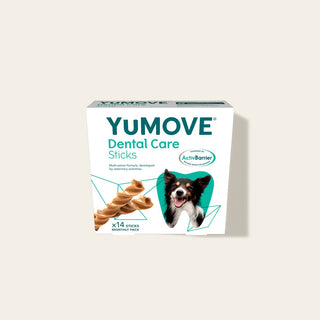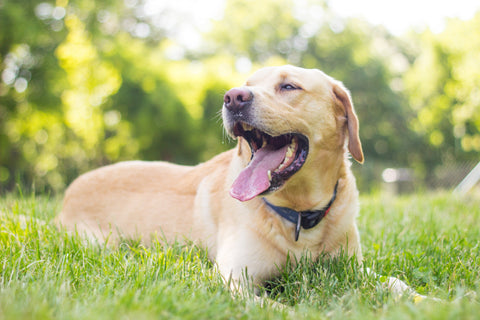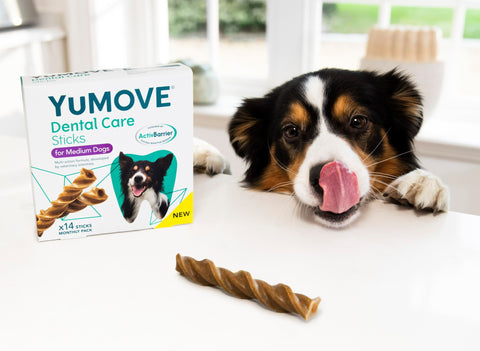

How healthy are your dog's teeth?
As pet parents, we all want our furry family members to be happy and healthy. With this in mind, are your dog’s teeth something you check regularly? Do you think you’d know if they had poor dental health?
Many dog owners aren’t aware of their dog's poor dental health until their vet points it out at their annual booster appointment. At this point, issues may have developed which need further attention of their dog's dental care.
To keep your dog's mouth as healthy as possible, it’s a good idea to check their gnashers regularly.
What creates an unhealthy mouth?
The process of plaque and calculus (tartar) building up in your dog's mouth is what creates an unhealthy oral environment. The hard deposit of plaque and tartar traps bacteria, creating an ideal environment in which they can multiply and, if not cleaned, increase the risk of developing dental disorders.
Over time, without dental care, the gum recedes and exposes the tooth root. Eventually, the tooth becomes very unstable and may fall out. It’s sadly incredibly common in dogs. Without a doubt, it’s something we want to avoid for our best furry pals, if possible.
What is plaque in dogs?
Plaque is a soft layer of bacteria and debris on the tooth surface that eventually becomes mineralised and forms tartar.
You can tell the difference between plaque and tartar by gently scraping the tooth's surface. If the discolouration comes away easily, you know it’s plaque. On the other hand, tartar feels like a hard coating or shell on the tooth and doesn't come off easily when you scrape at it.

How do you know if your dog’s mouth is unhealthy?
Unfortunately, many pet parents aren’t aware that their dog has poor dental health because they continue to eat and show very few signs of discomfort. So, what can you look out for?
- Bad breath (it’s a myth that it’s normal for dogs!)
- Dribbling
- Reduced appetite
- Dropping food or chewing on one side of their mouth
- Rubbing their face
- Licking their lips
- Preferring soft/wet food over crunchy/dry food
Find out more in our ‘Silent signs of dental discomfort’ guide.

What do healthy teeth and gums look like in dogs?
You might be so used to seeing dogs with tartar, plaque, and bad breath that you're not sure what a healthy dog's mouth looks and smells like! Let’s find out...
- Healthy teeth should be smooth and white-ish, with little or no plaque build-up.
- Healthy gums are usually salmon pink, or can be pigmented if your dog has a dark coat colour.
- The gum margin, which lies against the base of the tooth's crown, shouldn't look red or inflamed.
- The gum should meet the tooth at the margin between the crown and root, where the tooth narrows, leaving none of the root exposed.
- Aside from normal saliva, there should be no pus, blood or discharge surrounding the teeth.
The grades are in – how healthy is your dog’s mouth?
Because dental health varies between dogs and can get worse over time, it might be hard to determine where your dog sits on the scale. The following vet grading system will help you assess how healthy your dog’s mouth is, and whether you need to try more dental homecare or see a vet:
Grade 0
Grade 0 is where there’s no visible plaque or tartar on the teeth. The gums are healthy, with no signs of gum inflammation.
Grade 1
Grade 1 describes a small amount of visible plaque that can be easily removed with your finger, but no tartar. There’s usually no sign of inflammation, but if there is, it’s very mild reddening of the gums.
Grade 2
A dog with grade 2 dental health has some plaque and a small amount of tartar, with mild gum inflammation.
Grade 3
Grade 3 is when the plaque and tartar build-up are quite severe, and the gums are moderately inflamed. There can sometimes be mild gum recession too. However, there shouldn't be any obvious root exposure or significant tooth instability.
Grade 4
The most serious grade occurs when there’s severe tartar build-up and gingivitis. There’s usually significant gum recession, as well as infection and tooth instability.
When should you visit a vet?
If in doubt, we always recommend making an appointment with your vet – but you should certainly make an immediate appointment if you notice that your dog’s mouth is grade 3 or 4 on the dental scale.
If you notice signs of poor dental health, it’s likely that your dog is in significant discomfort. This is also the case if you've noticed behaviours such as dropping food or reduced appetite, or if your dog seems bothered by something in their mouth. In all of these instances, you should make an immediate appointment with your vet.
Once your dog has been treated, it’s then important to start a home dental care routine to keep their mouth and teeth healthy.
If your dog scores a lower grade on the dental scale, it’s time to review your homecare and bring it up with your vet the next time you see them. If you’re not regularly taking care of your dog’s teeth to improve their dental health, now is a really good time to start.
Keen to learn more about how to keep your dog in tip-top condition from nose to tail? Check out our other Health Guides for dog-focused articles packed with helpful info.




